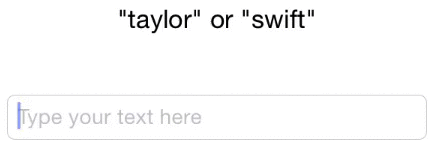The Specification design pattern implemented in swift for iOS/OSX.
In computer programming, the specification pattern is a particular software design pattern, whereby business rules can be recombined by chaining the business rules together using boolean logic.
Source: wikipedia.org
- Xcode 7.0 beta 4 (7A165t)
- Swift 2
- iOS 9.0+ / Mac OS X 10.10+
Chain two specifications into a single specification.
let s0 = RegularExpressionSpecification(pattern: "hello.*world")
let s1 = CountSpecification.between(20, 30)
let spec = s0 & s1
spec == "42"
# false, doesn't satify s0 and s1
spec == "hello world"
# false, s0 is satisfied, but not s1
spec == "say hello to the world today"
# trueBeyond the specification pattern itself, this project provides the following iOS/OSX specifications
- CharacterSetSpecification - for ensuring all characters in a string are of a certain kind, eg. all digits
- CountSpecification - for ensuring that a string/array isn't too long or short
- EmailSpecification - decide if an email is valid or not
- PredicateSpecification - if you don't want to subclass you can use this and instead provide a closure
- RegularExpressionSpecification - useful for string matching
Use the & operator when two specifications both must be satisfied.
Use the | operator when one of two specifications must be satisfied.
Use the ! operator when a specifications must not be satisfied.
Use the == operator to check if a candidate object satisfies the specification.
Use the != operator to check if a candidate object doesn't satisfy the specification.
In the following example, we are retrieving invoices and sending them to a collection agency if
- they are overdue,
- notices have been sent, and
- they are not already with the collection agency.
This example is meant to show the end result of how the logic is 'chained' together.
let overDue = OverDueSpecification()
let noticeSent = NoticeSentSpecification()
let inCollection = InCollectionSpecification()
// example of specification pattern logic chaining
let spec = overDue & noticeSent & !inCollection
for invoice in Service.invoices() where spec == invoice {
invoice.sendToCollection()
}The coloring are like this:
- Red, when the text neither can be "taylor" nor "swift"
- White, when the text is partially matching either "taylor" or "swift"
- Green, when the text is exactly "taylor" or exactly "swift".
You find this in the Basic_iOS project in the Examples folder.
- SwiftyFORM - A framework that makes it easier creating forms for iOS.
- Triangle Draw - A simple yet powerful drawing app for iOS.
- Colorblind Vision - An app that processes live video and presents it as a colorblind person would see it, for iOS.
- Newton Commander - An advanced file manager for Mac.
- GraphToy - A werkkzeug inspired tool for iPad.
- GraphicDesignerToolbox - A werkkzeug inspired tool for Mac.
- AEditor - A programming editor for Mac/Windows/Linux.
